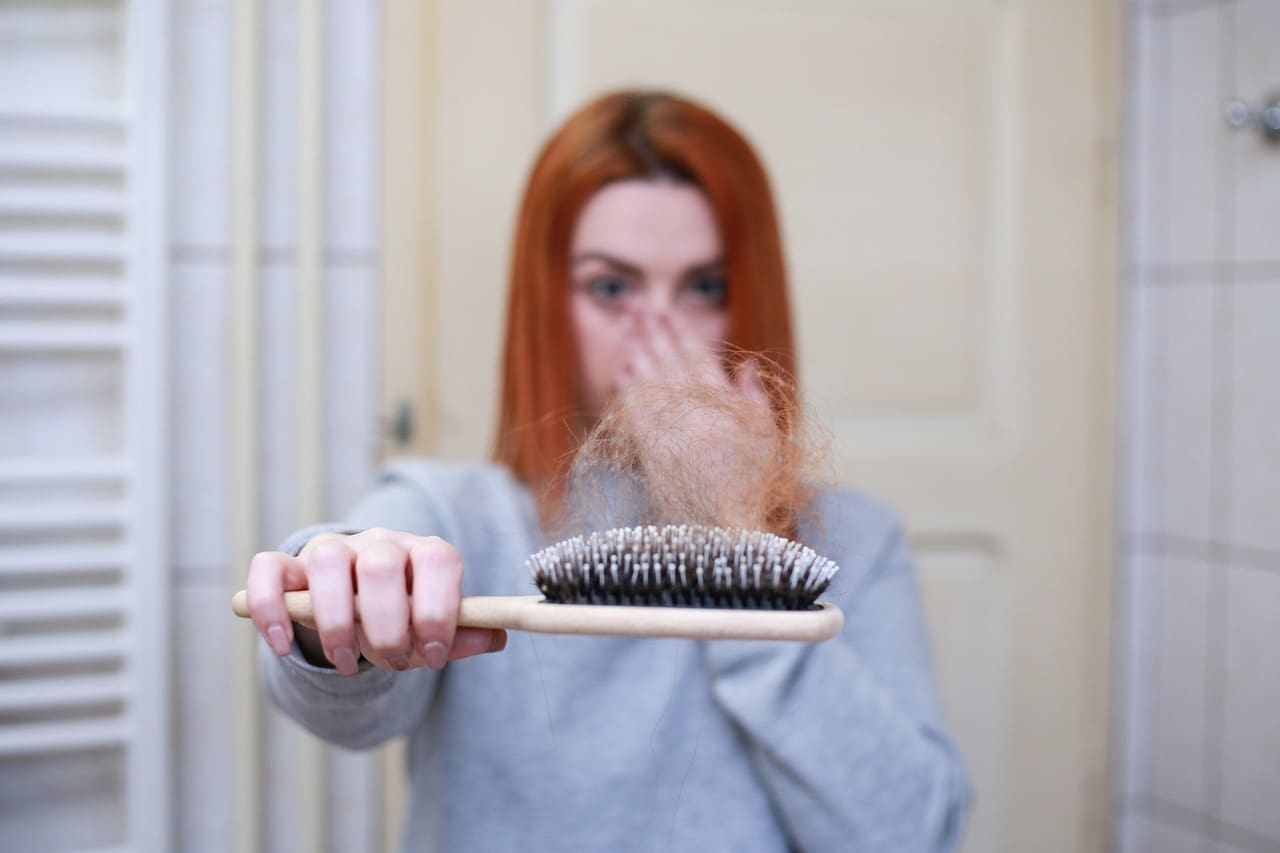Hair loss is a common issue that affects people of all races and genders, but women of color face unique challenges when dealing with this condition. The specific issues faced by women of color when it comes to hair loss require tailored solutions and a deeper understanding of their cultural practices and styling techniques.
Cultural factors play a significant role in hair loss among women of color. Many cultural practices, such as the use of chemical treatments like relaxers and dyes, can contribute to hair damage and breakage. Additionally, societal beauty standards often prioritize straight hair, which can lead to excessive heat styling and further hair loss.
There are several common causes of hair loss in women of color. Chemical treatments, such as relaxers and dyes, can weaken the hair shaft and cause it to break. Traction alopecia, a condition caused by tight hairstyles like braids, weaves, and ponytails, is also prevalent in women of color. Hormonal imbalances, such as polycystic ovary syndrome (PCOS), can also contribute to hair loss in women of color.
Addressing hair loss in women of color requires a multifaceted approach. It is essential to educate women about the damaging effects of chemical treatments and encourage them to embrace natural hair. Proper hair care routines, including regular moisturizing and gentle handling, can help prevent further hair loss. Protective styling, such as wearing wigs or opting for low-manipulation hairstyles, can also minimize damage.
Seeking professional help is crucial for women of color dealing with hair loss. Dermatologists and trichologists who specialize in the unique needs of women of color can provide personalized solutions and treatments. Additionally, supportive communities and resources that cater specifically to the needs of women of color dealing with hair loss can provide guidance and emotional support throughout the journey.
In conclusion, hair loss in women of color presents unique challenges that require tailored solutions. By understanding the cultural factors and common causes of hair loss, women of color can take proactive steps to address this issue. Embracing natural hair, adopting proper hair care routines, and seeking professional help are essential in combating hair loss and promoting self-acceptance.
Cultural Factors and Hair Loss
Cultural factors and styling techniques play a significant role in hair loss among women of color. The unique hair textures and structures of women of color require specific care and attention, and cultural practices often contribute to hair loss. For example, the use of chemical relaxers and dyes, which are commonly used to straighten or alter the natural texture of hair, can cause damage and weaken the hair follicles, leading to hair loss.
In addition to chemical treatments, certain styling techniques can also contribute to hair loss in women of color. Tight hairstyles such as braids, weaves, and ponytails can put excessive tension on the hair follicles, leading to a condition called traction alopecia. This condition is characterized by hair loss around the hairline and temples and is particularly common among women who regularly wear these types of hairstyles.
It is important to consider the impact of societal beauty standards on hair loss among women of color. Western beauty standards often prioritize straight hair, leading many women of color to feel the need to alter their natural hair texture. This constant manipulation and styling can put additional stress on the hair, leading to breakage and hair loss.
To address these cultural factors and minimize hair loss, it is crucial for women of color to embrace and celebrate their natural hair texture. This can involve adopting protective styling techniques that minimize tension on the hair, such as wearing loose braids or opting for low-manipulation hairstyles. Additionally, seeking professional help from dermatologists or trichologists who specialize in treating hair loss in women of color can provide valuable guidance and personalized solutions.
By understanding and addressing the cultural factors and styling techniques that contribute to hair loss, women of color can take proactive steps to maintain the health and integrity of their hair. Embracing natural hair and challenging societal beauty standards can empower women of color to redefine beauty on their own terms and embrace their unique hair textures.
Common Causes of Hair Loss
When it comes to hair loss in women of color, there are several common causes that can contribute to this issue. Understanding these primary factors is crucial in finding effective solutions and addressing the challenges faced by women of color.
Chemical Treatments: One of the leading causes of hair loss in women of color is the use of chemical treatments such as relaxers, dyes, and perms. These treatments often contain harsh chemicals that can damage the hair and scalp, leading to breakage and thinning. It is important for women of color to be cautious when using these products and to follow proper application and safety guidelines.
Traction Alopecia: Another significant cause of hair loss in women of color is traction alopecia. This condition is often associated with tight hairstyles like braids, weaves, and ponytails, which exert excessive tension on the hair follicles. Over time, this continuous pulling can lead to hair loss and thinning in the affected areas. It is important for women of color to choose hairstyles that do not put excessive strain on the hair follicles and to give their hair regular breaks from tight styles.
Hormonal Imbalances: Hormonal imbalances, such as polycystic ovary syndrome (PCOS), can also contribute to hair loss in women of color. These imbalances can disrupt the natural hair growth cycle and lead to excessive shedding. Women who suspect hormonal imbalances as the cause of their hair loss should consult with a healthcare professional for proper diagnosis and treatment options.
By identifying these common causes of hair loss in women of color, we can better understand the challenges faced and work towards finding effective solutions. It is important for women of color to prioritize proper hair care routines, avoid damaging chemical treatments, choose hairstyles that minimize tension on the hair follicles, and seek professional help when necessary. With the right approach and support, women of color can address hair loss and embrace their unique beauty.
Chemical Treatments and Hair Loss
Chemical treatments, such as relaxers, dyes, and other hair products, have become a common practice among women of color in their quest for diverse and versatile hairstyles. However, these treatments can have damaging effects on the hair and scalp, leading to hair loss. The chemicals used in relaxers, for example, can weaken the hair shaft and cause breakage, especially when used excessively or improperly.
Similarly, the use of dyes and bleaches can strip the hair of its natural moisture, leaving it dry and brittle. This can result in hair breakage and thinning over time. Additionally, some chemical treatments contain harsh ingredients that can irritate the scalp, leading to inflammation and hair loss.
It’s important to note that the negative effects of chemical treatments on hair loss are not limited to relaxers and dyes. Other treatments, such as perms, keratin treatments, and Brazilian blowouts, can also contribute to hair loss if not done correctly or if used excessively. These treatments often involve the use of strong chemicals and heat, which can weaken the hair and cause damage to the hair follicles.
To minimize the risk of hair loss from chemical treatments, it is crucial to follow proper application techniques and consult with a professional stylist who is experienced in working with women of color. It’s also important to give the hair time to recover between treatments and to use nourishing and moisturizing products to maintain the health of the hair and scalp.
In conclusion, while chemical treatments offer a wide range of styling options for women of color, they can also contribute to hair loss if not used with caution. It’s essential to be mindful of the potential damaging effects and take steps to protect and nourish the hair and scalp. By practicing proper hair care routines and seeking professional guidance, women of color can enjoy the benefits of chemical treatments while minimizing the risk of hair loss.
Traction Alopecia and Hairstyles
Traction alopecia is a type of hair loss that is commonly seen in women of color due to the tight hairstyles they often wear, such as braids, weaves, and ponytails. This condition occurs when constant tension is applied to the hair follicles, causing them to become damaged and eventually leading to hair loss.
When braids, weaves, or ponytails are styled tightly, they can pull on the hair and scalp, putting stress on the hair follicles. Over time, this repeated tension can weaken the follicles and cause them to become inflamed. As a result, the hair may start to thin out or break off, leading to patches of hair loss.
It is important for women of color to be aware of the potential risks associated with tight hairstyles and to take steps to prevent traction alopecia. One way to minimize the risk is to avoid hairstyles that put excessive tension on the hair and scalp. This may mean opting for looser braids or ponytails, or choosing hairstyles that do not require pulling the hair tightly.
Additionally, it is crucial to give the hair and scalp regular breaks from tight hairstyles. This can be done by alternating between different styles or allowing the hair to rest and breathe without any tension for a period of time. It is also important to avoid using excessive heat or harsh chemicals on the hair, as these can further weaken the follicles and contribute to hair loss.
If traction alopecia has already developed, it is important to seek professional help and take steps to promote hair regrowth. This may involve using topical treatments or medications that stimulate hair growth, as well as adopting a gentle hair care routine that promotes a healthy scalp environment.
In conclusion, tight hairstyles such as braids, weaves, and ponytails can contribute to the development of traction alopecia in women of color. It is important to be mindful of the tension placed on the hair and scalp and take steps to prevent and address hair loss. By choosing looser styles, giving the hair regular breaks, and seeking professional help when needed, women of color can minimize the risk of traction alopecia and maintain healthy, beautiful hair.
Hormonal Imbalances and Hair Loss
Hormonal imbalances, such as polycystic ovary syndrome (PCOS), can play a significant role in causing hair loss in women of color. PCOS is a condition that affects the hormonal balance in the body, leading to symptoms such as irregular periods, weight gain, and acne. One of the lesser-known effects of PCOS is hair loss, which can be particularly distressing for women of color.
PCOS-related hair loss in women of color is often characterized by thinning hair on the scalp, as well as excessive shedding. This can be attributed to the elevated levels of androgens (male hormones) in the body, which can disrupt the natural hair growth cycle. As a result, the hair follicles become miniaturized and produce thinner, weaker strands of hair.
Fortunately, there are potential treatments available to address hair loss caused by hormonal imbalances in women of color. One commonly used treatment is medication, such as anti-androgen drugs or oral contraceptives, which can help regulate hormone levels and minimize hair loss. Additionally, lifestyle changes, such as maintaining a healthy diet and managing stress levels, can also contribute to hormonal balance and promote hair growth.
It’s important for women of color experiencing hair loss due to hormonal imbalances to consult with a healthcare professional or dermatologist who specializes in treating hair loss. They can provide a comprehensive evaluation and recommend the most suitable treatment options based on individual needs and circumstances.
Addressing Hair Loss: Solutions and Tips
Addressing Hair Loss: Solutions and Tips
When it comes to dealing with hair loss, women of color face unique challenges. However, there are practical solutions and tips that can help address this issue and promote hair growth and health. Here are some strategies that women of color can incorporate into their hair care routines:
- Proper Hair Care Routines: Establishing a consistent hair care routine is crucial for maintaining healthy hair and preventing further hair loss. This includes using gentle, sulfate-free shampoos and conditioners specifically formulated for your hair type. Regularly moisturizing the hair and scalp with natural oils or leave-in conditioners can also help nourish the hair follicles and promote growth.
- Protective Styling: Protective hairstyles can help minimize hair breakage and protect the hair from external damage. Opt for styles such as braids, twists, or buns that keep the ends of the hair tucked away and reduce manipulation. Be mindful of not pulling the hair too tightly, as this can lead to traction alopecia.
- Seeking Professional Help: If you’re experiencing significant hair loss or are unsure about the underlying cause, it’s important to consult a professional. A dermatologist or trichologist specializing in hair and scalp health can provide a thorough evaluation and recommend appropriate treatments or interventions.
It’s important to remember that addressing hair loss requires patience and consistency. Results may not be immediate, but with the right approach and care, women of color can achieve healthier and fuller hair.
Embracing Natural Hair and Self-Acceptance
Embracing Natural Hair and Self-Acceptance
Promoting self-acceptance and embracing natural hair can be a powerful way for women of color to combat hair loss. In a society that often upholds Eurocentric beauty standards, it is important for women of color to redefine what beauty means to them and embrace their unique hair textures.
One of the first steps towards self-acceptance is understanding that hair loss does not define a person’s worth or beauty. By embracing their natural hair, women of color can challenge societal norms and create a new standard of beauty that celebrates diversity.
Embracing natural hair also involves adopting healthy hair care routines that nourish and protect the hair. This can include using gentle products specifically designed for textured hair, minimizing heat styling, and moisturizing regularly. By taking care of their hair, women of color can promote its growth and overall health.
Another way to embrace natural hair is through protective styling. This involves wearing hairstyles that minimize manipulation and tension on the hair, such as braids, twists, or buns. Protective styles not only help prevent further hair loss but also allow for the hair to grow and thrive.
Lastly, seeking support from like-minded communities and resources can be invaluable in the journey towards self-acceptance. Online forums, social media groups, and local support groups can provide guidance, encouragement, and emotional support for women of color dealing with hair loss. Connecting with others who have similar experiences can help foster a sense of belonging and empowerment.
In conclusion, embracing natural hair and self-acceptance can be a transformative journey for women of color experiencing hair loss. By redefining beauty standards and embracing their unique hair textures, women of color can find empowerment, confidence, and a renewed sense of self. Through healthy hair care routines, protective styling, and supportive communities, women of color can navigate the challenges of hair loss with grace and resilience.
Supportive Communities and Resources
Supportive communities and resources play a crucial role in addressing the unique challenges faced by women of color dealing with hair loss. These communities and resources are specifically tailored to cater to the needs of women of color, providing them with the guidance and emotional support they require during this difficult time.
One of the key benefits of supportive communities is the sense of belonging and understanding that they offer. When women of color come together in these communities, they can share their experiences, frustrations, and triumphs with others who can relate to their journey. This creates a safe space where they can openly discuss their concerns and seek advice from others who have faced similar challenges.
Supportive communities also provide a wealth of resources that can help women of color navigate their hair loss journey. These resources may include educational materials, such as articles and videos, that provide information on the causes of hair loss, treatment options, and tips for maintaining healthy hair. They may also offer access to professional experts who specialize in hair loss in women of color, providing valuable insights and personalized advice.
In addition to supportive communities, there are various resources available that focus specifically on the needs of women of color dealing with hair loss. These resources may include websites, blogs, and social media platforms that provide a wealth of information and support. They may also feature forums or online support groups where women can connect with others who are going through similar experiences.
Overall, supportive communities and resources are essential for women of color dealing with hair loss. They not only provide guidance and emotional support but also empower women to embrace their unique hair textures and redefine beauty standards. By coming together and sharing their stories, women of color can find strength and inspiration, knowing that they are not alone in their journey towards self-acceptance and hair loss solutions.
Frequently Asked Questions
- Q: How do cultural practices and styling techniques contribute to hair loss in women of color?
- Q: What are some common causes of hair loss in women of color?
- Q: How do chemical treatments contribute to hair loss?
- Q: What is traction alopecia and how does it relate to hairstyles?
- Q: Can hormonal imbalances cause hair loss in women of color?
- Q: What are some solutions and tips for addressing hair loss in women of color?
- Q: How can embracing natural hair help combat hair loss?
- Q: Are there supportive communities and resources available for women of color dealing with hair loss?
A: Cultural practices and styling techniques, such as frequent heat styling, chemical treatments, and tight hairstyles, can put excessive stress on the hair and scalp. This can lead to hair breakage, thinning, and even traction alopecia, a type of hair loss caused by constant pulling or tension on the hair follicles.
A: Some common causes of hair loss in women of color include the use of harsh chemical treatments like relaxers and dyes, traction alopecia from tight hairstyles, hormonal imbalances like polycystic ovary syndrome (PCOS), and even certain medications or medical conditions.
A: Chemical treatments, such as relaxers and dyes, can weaken the hair shaft and strip the scalp of its natural oils. This can result in dry, brittle hair that is more prone to breakage and hair loss. Additionally, some of the chemicals used in these treatments can cause scalp irritation and inflammation, further contributing to hair loss.
A: Traction alopecia is a form of hair loss caused by continuous pulling or tension on the hair follicles. Tight hairstyles like braids, weaves, and ponytails can exert constant pressure on the hair, leading to hair breakage and eventual hair loss in the affected areas.
A: Yes, hormonal imbalances, such as polycystic ovary syndrome (PCOS), can contribute to hair loss in women of color. Hormonal fluctuations can disrupt the hair growth cycle, leading to excessive shedding and thinning of the hair.
A: It is important to establish a proper hair care routine that includes gentle cleansing, moisturizing, and regular conditioning. Protective styling, such as wearing loose braids or buns, can help minimize hair breakage. Seeking professional help from a dermatologist or trichologist can also provide personalized advice and treatment options for hair loss.
A: Embracing natural hair can reduce the reliance on chemical treatments and heat styling, which can cause damage and hair loss. By embracing their unique hair textures, women of color can promote healthier hair growth and reduce the risk of further hair loss.
A: Yes, there are supportive communities and resources specifically catered to the needs of women of color dealing with hair loss. Online forums, social media groups, and organizations dedicated to hair care can provide guidance, emotional support, and helpful tips for managing and overcoming hair loss challenges.








Leave a Reply